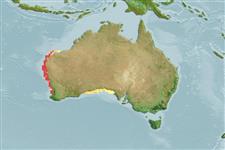>
Blenniiformes (Blennies) >
Blenniidae (Combtooth blennies) > Salariinae
Etymology: Cirripectes: Latin, cirrus = curl fringe + Greek, pektos, -e, -on = made of several parts solidly united (Ref. 45335); hutchinsi: Named for Barry Hutchins of the Western Australian Museum..
Environment: milieu / climate zone / depth range / distribution range
экология
морской ассоциированный с рифами; пределы глубины 1 - 22 m (Ref. 529). Subtropical; 20°S - 33°S
Eastern Indian Ocean: known only from Western Australia (North West Cape southward to Rottnest Island).
Length at first maturity / Size / Вес / Возраст
Maturity: Lm ?, range 7 - ? cm
Max length : 10.6 cm SL самец/пол неопределен; (Ref. 529)
Краткое описание
морфология | морфометрия
колючие лучи спинного плавника (общее число): 12 - 13; членистые (мягкие) лучи спинного плавника (общее число): 13-14; колючие лучи анального плавника 2; членистые (мягкие) лучи анального плавника: 15 - 16; позвонки: 30 - 31. Diagnosis: Dorsal fin XII, 14, membrane attached to caudal fin, with deep notch above last spine, first spine almost same or slightly higher than second; anal fin II, 15; pectoral rays 15; pelvic fin I, 4; caudal fin procurrent rays 11-14. Vertebrae 10 + 20-21. LL, without scales and scalelike flaps; LL tubes 3-9 (usually 8-13), canal ends below posterior to 13h dorsal ray, usually on caudal-fin base. Upper lip crenulae 36-42. Gill rakers 23-29. Cephalic sensory pore system complex. Cirri, nuchal 35-42, nasal 8-93, supraorbital 12-29; 4 groups of nuchal cirri, each ventralmost group borne on slightly expanded nuchal flap. No pores at extra interorbital pore position. Geographic variation in color pattern exists in females; 2 color patterns in male may exist in the same geographic area; background color brown; yellow to orange iris (Ref. 529).
Facultative air-breathing in the genus (Ref. 126274); Found in the surge zone in limestone holes just below the intertidal range. Common in areas where Pocillopora damicornis is present on the reefs (Ref. 529). Oviparous. Eggs are demersal and adhesive (Ref. 205), and are attached to the substrate via a filamentous, adhesive pad or pedestal (Ref. 94114). Larvae are planktonic, often found in shallow, coastal waters (Ref. 94114).
Oviparous, distinct pairing (Ref. 205). Urogenital orifice of male genital papilla located basally between 2 widely separated slender filaments on a fleshy swelling behind anus; testes bulbous with length equal to its width (Ref. 529).
Williams, J.T., 1988. Revision and phylogenetic relationships of the blenniid fish genus Cirripectes. Indo-Pac. Fish. (17):78 p. (Ref. 529)
Статус Красного Списка МСОП (Ref. 130435)
Угроза для людей
Harmless
Использование человеком
рыболовство: интереса не представляет
дополнительная информация
Возраст/РазмерыростЗависимость между длиной и массой телаЗависимость между длинамиРазмерный составморфометрияморфологияличинкидинамика численности личинокпополнениечисленностьBRUVS
ссылкиаквакультура (рыбоводство)особенности рыбоводствастепень растяжениягенетикаElectrophoresesнаследуемостьболезниобработкаNutrientsMass conversion
соавторыизображенияStamps, Coins Misc.звукиCiguateraскоростьтип плаванияжаберная областьOtolithsмозгзрение
инструменты
Специальные отчеты
Скачать в формате XML
ресурсы в Интернет
Estimates based on models
Preferred temperature (Ref.
123201): 18.1 - 26.7, mean 22.2 °C (based on 115 cells).
Phylogenetic diversity index (Ref.
82804): PD
50 = 0.5000 [Uniqueness, from 0.5 = low to 2.0 = high].
Bayesian length-weight: a=0.01072 (0.00480 - 0.02393), b=3.01 (2.82 - 3.20), in cm total length, based on LWR estimates for this (Sub)family-body shape (Ref.
93245).
Trophic level (Ref.
69278): 2.0 ±0.00 se; based on food items.
устойчивость к внешним воздействиям (Ref.
120179): высокий, минимальное время удвоения популяции до 15 месяцев (Preliminary K or Fecundity.).
Fishing Vulnerability (Ref.
59153): Low vulnerability (10 of 100).
Nutrients (Ref.
124155): Calcium = 79.9 [29.7, 158.9] mg/100g; Iron = 0.851 [0.471, 1.527] mg/100g; Protein = 19 [18, 20] %; Omega3 = 0.202 [0.108, 0.368] g/100g; Selenium = 10.3 [4.7, 23.1] μg/100g; VitaminA = 75.6 [20.1, 285.3] μg/100g; Zinc = 1.67 [1.04, 2.65] mg/100g (wet weight);
